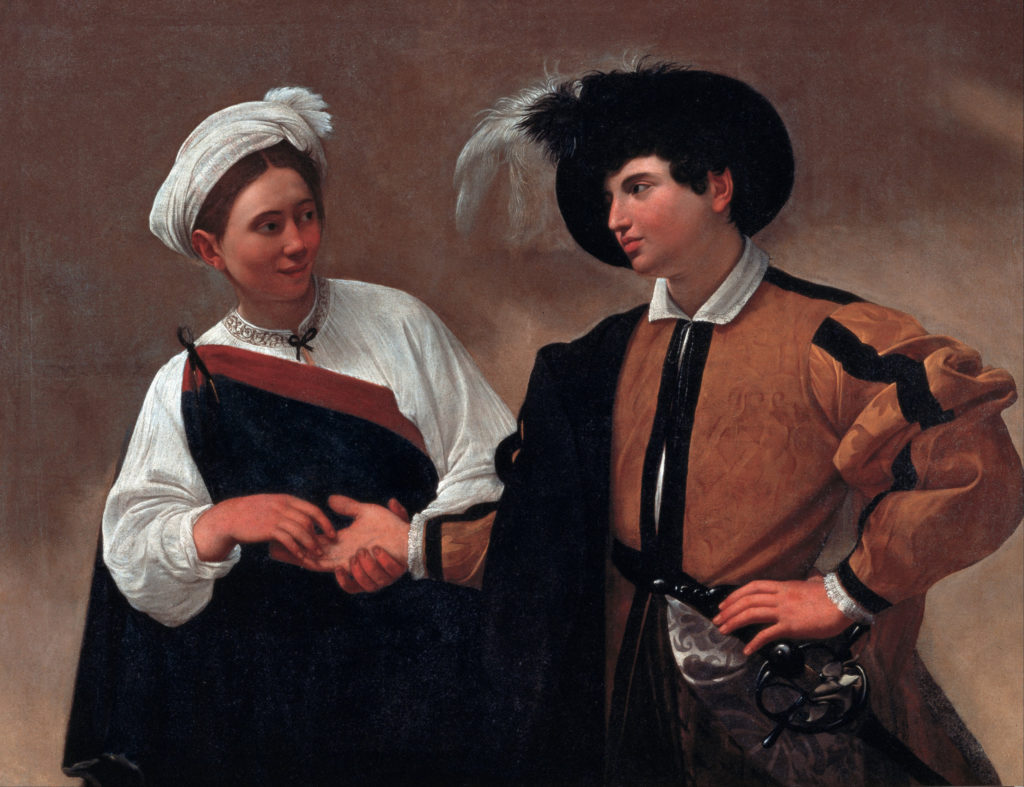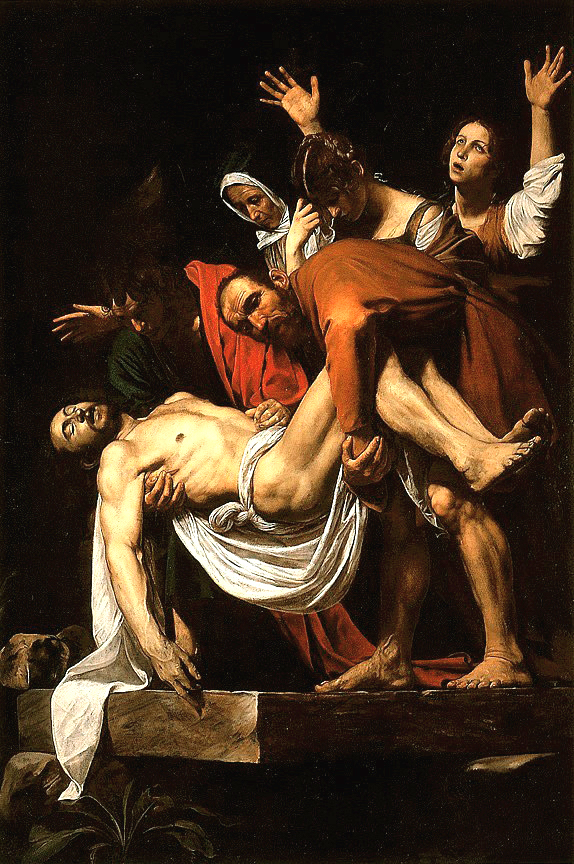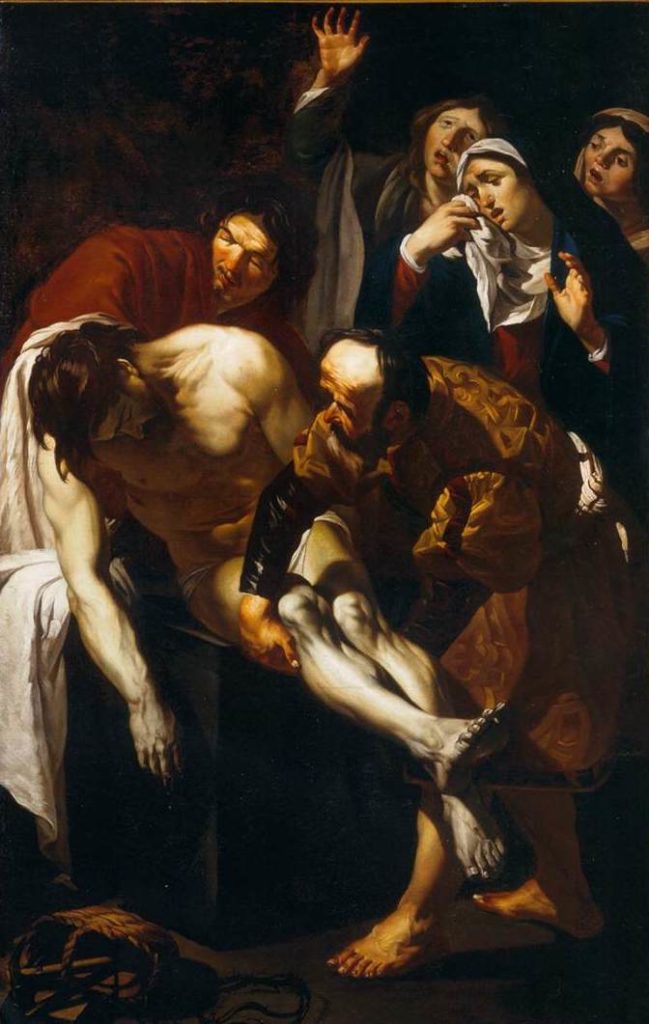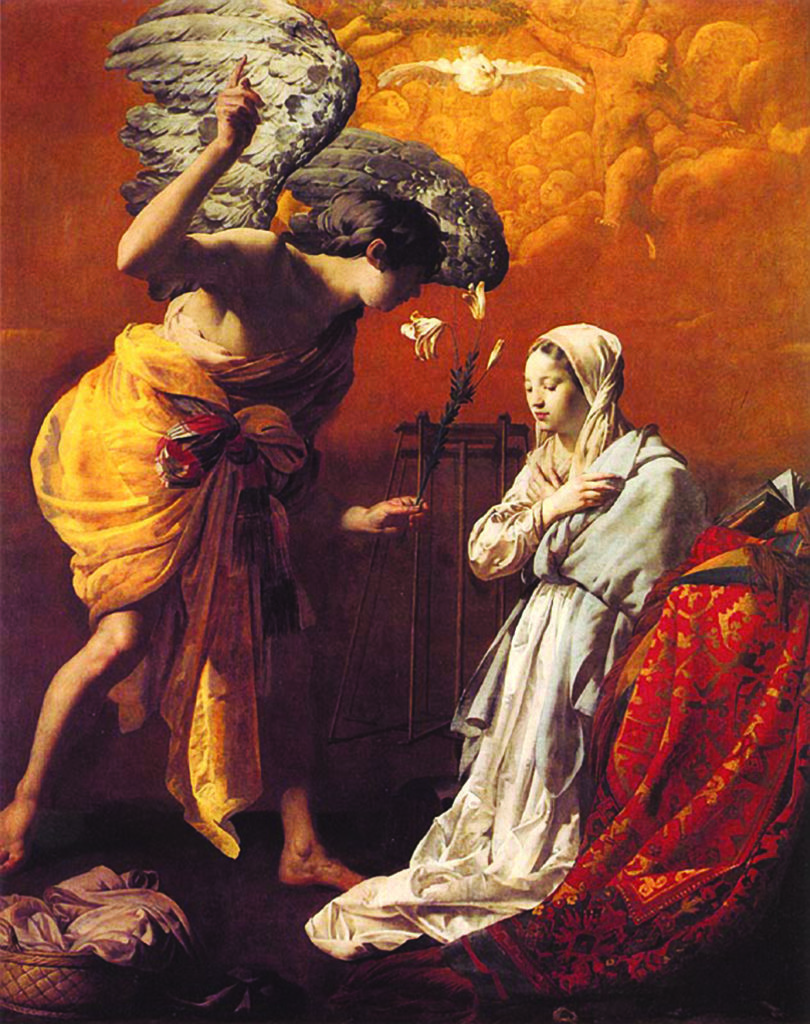
By Andrea M. Gáldy -
Around the mid 1610s, Hendrick ter Brugghen (1588–1629), Gerard van Honthorst (1592–1656) and Dirck van Baburen (c.1592/93–1624) spent time in Italy, particularly in Rome, where they came face to face with Caravaggio’s work. Similar to what happened to Caravaggisti from other parts of Europe, the three young painters from Utrecht apparently were so struck by Caravaggio’s dramatic and monumental works that they would carry this new influence back north. From what can be witnessed in the current show at Munich‘s Alte Pinakothek, featuring 75 Caravaggist paintings, this early impression remained forceful enough to last a lifetime of artistic production.
While the work of Caravaggio (Michelangelo Merisi, 1571–1610) is famous for its dramatic effects of chiaroscuro on depictions of scenes such as the Entombment of Christ (Fig. 1, cat. 22,1602–1603) for the Vittrice family chapel in the Chiesa Nuova in Rome (now Vatican Museums), the depth of emotions expressed as well as the nitty-gritty realism including the bodily and mental ugliness of human beings must also have seemed like a thunderbolt to patrons and artists. The Passion of Christ is a recurrent theme in Caravaggio’s art together with some of the more violent scenes from the Old Testament. Bloodshed and the process and effect of torture are depicted with such gusto that The Fortune Teller (Fig. 2, cat. 73, 1595/96, Capitoline Museums) seems very tame in comparison.
As already mentioned above, Caravaggio’s art was highly influential on his colleagues in Italy and in the rest of Europe. The Low Countries, and I use this term in its widest possible sense, had long been a hub of artistic production and courtly splendour. The exchange of works of art and artists with Italy was thriving by the fifteenth century and, during the region’s unstable history, at times included artistic milieus of Austria, Spain and Poland-Lithuania to mention but a few. Seventeenth-century Utrecht, both city and province, was a cosmopolitan place of wealth and education, in which political and religious strife caused turmoil enough but apparently had surprisingly little effect on the local painters’ guild. Wars and upheaval meant, however, that it became less easy for artists to attract patronage and clients and therefore they needed to find inspiration and access the art market elsewhere. In the early seventeenth century, Rome was a likely place to pick up ideas and commissions, since the capital of Catholicism had started to gain projects and pilgrims. The rich ecclesiastical culture was matched by an antiquarian engagement with ancient remains, a lively literary and musical scene and scholarly pursuits. For less highbrow entertainment, the eternal city provided taverns, gaming dens and brothels. Nonetheless, it was the role of Rome as the revived artistic centre that made so many artists visit and familiarise themselves with the latest trends, Caravaggism chief among them.

The three fiamminghi, ter Brugghen, van Honthorst and van Baburen, used their time in Rome to become proficient in the new style and to enjoy the many diversions offered in Rome. They also started to work for Italian patrons who already owned works by Caravaggio as in the case of the Medici Grand Dukes in Florence. Once the situation back home started to improve, they returned to Utrecht to run successful workshops and to work on their international reputations which in time would gain Honthorst an invitation to work at the court of the Stuart King Charles I.

In some of their works, such as in van Baburen’s versions of the Entombment (Fig. 3, cat. 21, 1617-18, Centraal Museum, Utrecht) the borrowing of themes and rendering from Caravaggio’s oeuvre is quite obvious, although it is easy to see that and how the subject matter is being developed to become even more dramatic and emotional. Where the Utrecht influence becomes perhaps even more noticeable is in Honthorst’s Liberation of St Peter (cat. 12, c.1616-18, State Paintings Gallery, Berlin), for which the northern painter used Caravaggio’s example of the Calling of St Matthew (San Luigi dei Francesi, Rome) and thus a different theme as his painterly model. Certainly one of the most striking paintings in the context of the exhibition must be ter Brugghen’s Annunciation (Fig. 4 Cat. 78, 1629, Stadsmuseum De Hofstedt, Diest), in which the artist set the three-dimensionality of angel and virgin and the realism of the splendid fabrics against an almost flat gold-coloured background reminiscent of his 1625 Crucifixion (Cat. 76) in a fifteenth-century tradition with a Caravaggist twist.

This Ter Brugghen 1629 Annunciation, one of several versions the artist made, has one of the youngest and most innocent and tender portraits of a Mary – she’s clearly a real person and looks hardly mid-adolescent – in all of Nativity art (see detail below), according to Patrick Hunt in his book Puer Natus Est: The Art of Christmas, 2011.

The final part of the exhibition and seemingly at odds with so many large-format altarpieces with tortured and dead people is dedicated to the low-life entertainment the painters from Utrecht had encountered in Rome – although it is hard to believe they would not have known something like it back home. In these paintings, partying, drinking, procuring and gaming are presented with some of the dangers entailed. Honthorst’s Debauched Student (cat. 29, 1625, Alte Pinakothek, Munich) and his Concert (cat. 66, 1623, National Gallery of Art, Washington) are only two examples – one by day, one by night – in which a strong light falls onto white skin and gorgeous fabrics to reveal lewd undercurrents and sexual connotations detectable by the initiated through particular gestures that accompany the music making, eating and drinking of wine (also see the Merry Company with a Lute Player, cat. 28, 1619-20, Uffizi, Florence). There is of course a connection to some of the Caravaggisti’s earlier work and – surprisingly – to his Denial of St Peter (Cat. 9, 1616-17, Musée des Beaux-Arts, Rennes). The Denial was a very popular subject painted repeatedly in the early seventeenth century by the Utrecht Caravaggisti and their European colleagues. These paintings show the scene of Peter’s betrayal in what looks like a tavern with people at table playing cards. The maid in the house of the high priest, holding the candle that provides the main dramatic source of light, looks not so different from the – admittedly less dishevelled – tavern wenches in some of the other convivial paintings.
The current exhibition brings together a huge number of blockbuster paintings mostly exhibited in a shadowy gallery setting that agrees with the chiaroscuro of the works of art. The hanging emphasises Caravaggio’s influence on his followers from Utrecht but somehow does not manage to explain the development the models went through once Honthorst and his colleagues started to experiment with themes and lighting. Rather, one could get the impression that bloodied bodies alone dominated the artistic production until one suddenly gets to the final section full of parties and innuendo. It is also hard to imagine how the public will be able to view the large altarpieces, made to be seen at a distance, on a busy day in the galleries. The catalogue is a different matter since it sets the scene at Utrecht and Rome and gives context to the religious-political milieu, for which the paintings were made; it provides short biographies of the relevant artists and has a very richly illustrated catalogue section that makes the hindsight on the exhibition very profitable indeed.
UTRECHT, CARAVAGGIO AND EUROPE
ALTE PINAKOTHEK, MUNICH
EXHIBITION DATES | was 17 APRIL–21 JULY 2019
EXTENDED OPENING HOURS FOR THE EXHIBITION:
TUESDAYS AND WEDNESDAYS UNTIL 9.00 P.M.
Bernd Ebert and Liesbeth M. Helmus, eds. Utrecht, Caravaggio and Europe. Munich: Bayerische Staatsgemäldesammlungen/Hirmer, 2018.